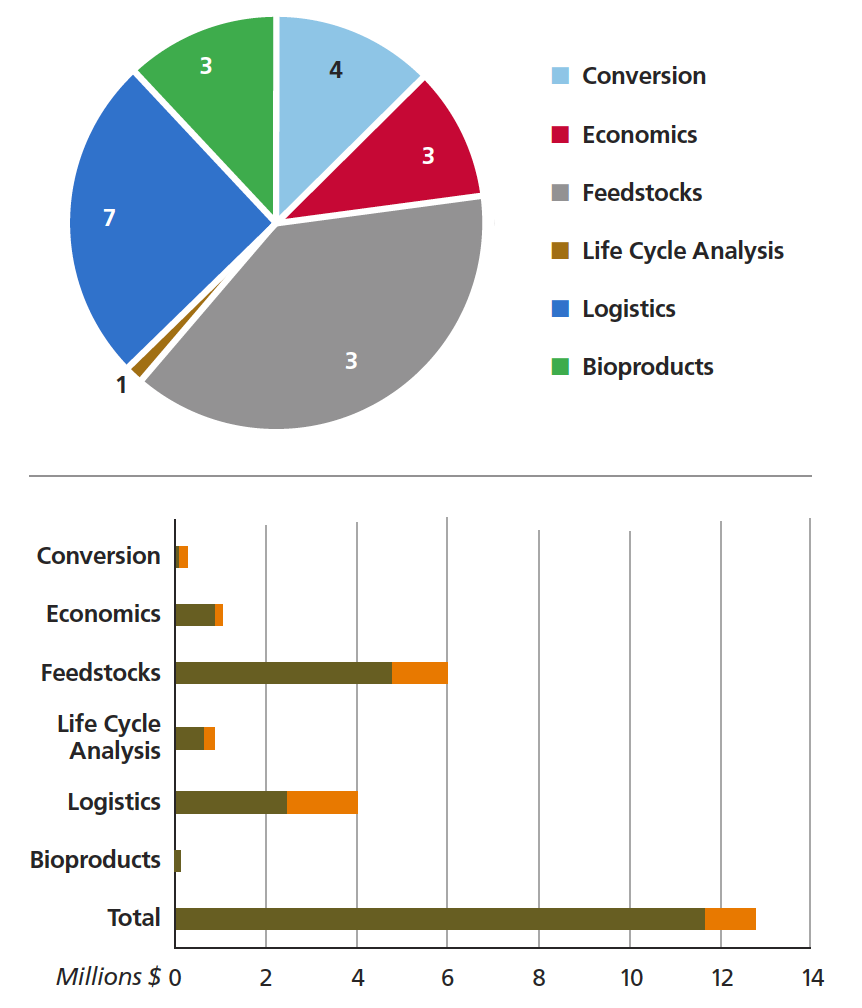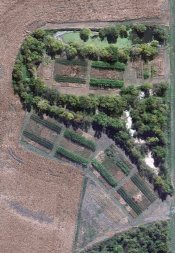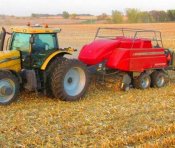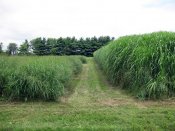Sun Grant Initiative Competitive Grants Program
From 2008-2017, the Sun Grant Initiative partnered with the U.S. Department of Energy to manage a competitive grants program. The overall goal of this program was to utilize congressionally directed funds to leverage the North Central Regional Sun Grant’s Competitive Grant program at SDSU to address key issues and research gaps related to development of the bio economy. Specific objectives of this program were to:
- Identify research projects through a Regional Competitive Grants program that were relevant to the sustainable production, harvest, transport, delivery and processing/conversion of cost-competitive, domestically grown biomass.
- Build local expertise and capacity at the North Central Regional Sun Grant Center at SDSU through an internal selection of key bioenergy research projects.
Of these funds, 75 percent were allocated to the Regional Competitive Grants Program and 25 percent were dedicated to building local expertise and strength at SDSU. Three nationwide and two internal competitions were completed. Priority areas for these competitions included:
- Biomass feedstock logistics including biomass harvesting, handling, transportation, storage and densification;
- Sustainable biomass feedstock production systems including biomass crop development, production and life-cycle analysis;
- Biomass production systems that optimize biomass feedstock yield and economic return across a diverse landscape while minimizing negative effects on the environment and food/feed production; and
- Promotion of knowledge-based economic development in science and technology and to advance commercialization of inventions that meet the mission of the Sun Grant Initiative. A total of 33 projects were selected for funding through this program. Primary research topics as well as funding associated with each subject area are shown in Figure 3.
The Final Technical Report

Department of Energy Regional Feedstock Partnership
The Regional Feedstock Partnership was formed in 2008 by the United States Department of Energy and the Sun Grant Initiative to address issues associated with the development of a sustainable and projectable supply of cellulosic feedstocks.
Department of Energy Research Grant Awardee
Although not inclusive, several key impacts from various projects funded through this award are highlighted below.
- University of Minnesota researchers are developing a web based decision support tool (CE2T—The Crop Enterprise and Environmental Budgeting Tool) to allow a broad set of users to make informed decisions about the economic and environmental value of perennial based biomass crop production on the landscape (Figure 1).

Figure 2: Overhead view of one of several locations where diverse biomass feedstocks were evaluated across a landscape for development. - A SDSU project created the opportunity for researchers to discover a way to treat soybean meal and dried distillers grains from corn ethanol plants to make a protein-rich fish feed that can fully replace fishmeal in aquaculture diets (Figure 2). This work led to a patented process and a Brookings-based startup company to commercialize the technology - Prairie AquaTech. Prairie AquaTech has grown to 30 employees since its inception and is currently constructing a 300,000 square foot, $60 million commercial facility with plans to hire 35 additional employees once the plant is operational. Prairie AquaTech has the capability to help solve the global problem of high-quality animal feed ingredients, help secure the world’s food supply, and provide a solution to the U.S.’s problem of the largest natural resource trade deficit by starting more aquaculture farms with a locally available feed ingredient.

Figure 3: Harvesting corn stover for Matt Darr’s North Central Regional Sun Grant project. Photo courtesy of Matt Darr, Iowa State University. - Researchers at Iowa State University partnered with DuPont, New Holland and AGCO in Sun Grant projects to better understand how feedstock densification and storage can improve conversion of corn stover to biofuels. This research in biomass supply chains has provided guidance for AGCO to set goals for biomass machinery design and allowed their machines to operate at peak efficiency throughout the harvest season (Figure 3).

Figure 4: Miscanthus (right side) and switchgrass (left side) plots in Indiana. Photo courtesy of Jeff Volenec, Purdue University. - SDSU researchers developed a novel plasma activation system to efficiently create nano structured porous bio-char suitable for super capacitors. The plasma activation technology developed through this project has attractive potential for commercialization because plasma activation was completed with only 50 watts of power in five minutes, thus greatly reducing the cost of super capacitors.
- Purdue University researchers characterized the opportunities and challenges associated with producing a range of perennial bioenergy crops including miscanthus (Figure 4), switchgrass and mixed prairie grasses, across landscapes which are considered marginal. Specifically, they identified those crops that provide the highest yields as well as the greatest theoretical return to producers, the role of fertilization, costs to the environment (through greenhouse gas emission and nitrate leaching) and establishment and transportation costs.
- Four invention disclosures;
- Eight patents;
- More than 30 jobs created; and
- Training of undergraduate (110), M.S. (39) and Ph.D. (38) students and post-docs (27).
- More than 100 peer-reviewed publications;
- Five book chapters;
- More than 275 presentations to diverse audiences; and
- Nearly 40 outreach publications.
All projects funded through DOE are listed below along with the lead investigator and her or his institution:
- Optimizing the Logistics of a Mobile Fast Pyrolysis System for Sustainable Bio-Crude Oil Production; S. Capareda; Texas A&M University
- Evaluation of In-Field Corn Stover Densification and Interaction with Storage Quality, Logistics and Production Costs; M. Darr; Iowa State University
- Prioritizing Corn Harvest and Biomass Collection Activities; C. Gustafson, North Dakota State University
- The Logistics of Herbaceous Crop Residue-based Ethanol Production Under Uncertainty; D. Lambert; North Dakota State University and Kansas State University
- Strategies for Concurrent Wet Storage and Pretreatment of Corn Stover; Y. Li; Ohio State University
- Improving Handling Characteristics of Herbaceous Biomass; V. Morey; University of Minnesota
- Transforming and Densifying Biomass in Regional Biomass Processing Centers; K. Muthu; South Dakota State University
- In-Field Cubing of Cellulosic Biomass; K. Shinners; University of Wisconsin
- Landscape Scale Lignocellulosic Biomass Production; C. Johnson; South Dakota State University
- Biofuel Crops in Eastern South Dakota Establishment, Productivity, Biotic Impact and Multiple Use Potential; P. Johnson; South Dakota State University
- Interactions of Biochar/Bio-ash Source/Properties Impacts on Soil Properties, C Sequestration Potential and Crop Management; D. Malo; South Dakota State University
- Wind Resource Assessment Network; D. Todey; South Dakota State University
- Seed Technologies to Secure Rapid and Complete Switchgrass Establishment; B. Baldwin; Mississippi State University
- Barley Straw Fructanosic Ethanol for On-Farm Biofuel Production; T. Blake; Montana State University
- Optimization of Biomass Productivity and Environmental Sustainability for Cellulosic Feedstocks: Land Capability and Life Cycle Analysis; S. Brouder; Purdue University
- Do Nurse Crops Make Miscanthus Giganteus Establishment More Sustainable?; E. Heaton; Iowa State University
- Sustainable Biomass Production on Marginal Lands Using a Novel legume/Grass Mixture; V. Owens; South Dakota State University
- Evaluation of Bioenergy Crop Production on Marginal Land in Wisconsin; S. Ventura; University of Wisconsin-Madison
- Cup Plant as a Potential New Biomass Crop; A. Boe; South Dakota State University
- Biofuel Feedstock Crops in Sub-Irrigated Lowlands; C. Johnson; South Dakota State University
- Pyrolysis of Forest Residue; L. Wei; South Dakota State University
- Using Second-Generation Biofuel Feedstocks to Improve the Carbon Economy of US Agriculture; E. DeLucia; University of Illinois
- Improving Production, Resilience and Biodiversity of Perennial Grass Mixtures and Monocultures as Biofuel Feedstocks Across Environmentally Heterogeneous Landscapes; C. Johnson; South Dakota State University
- Production and Economics of Perennials-Based Woody and Herbaceous Biomass Crops Under Alley-Cropping Systems; G. Johnson; University of Minnesota
- Intensifying the Corn-Soybean Rotation with the Use of Winter Rye Grown for Biomass Energy Production; P. Sexton; South Dakota State University
- Beneficial Plant Microbe Interactions and Their Potential Application to Increase Biomass Production and Environmental Sustainability of Prairie Cordgrass; H. Bucking; South Dakota State University
- Develop Solid-stem Triticale as a Feedstock for Biofuel Production; W. Li; South Dakota State University
- Electrophoretic Deposition of Biochar Nanoparticle Based Films for Energy Storage; Q. Fan; South Dakota State University
- Developing Gas Stripping-Absorption/Desorption Processes Based on Porous Carbon Adsorbents for Biofuel Purification from Bioreactors; Z. Gu; South Dakota State University
- Catalytic Fast Pyrolysis Conversion of Corn Stover to Drop-in Quality Hydrocarbons; L. Wei; South Dakota State University
- Plasma Activation of Biochar for Supercapacitors; Q. Fan; South Dakota State University
- Engineering Aurebasidium pullulans to Produce and Secrete Beta Glucans and Poly-lysine; J. Gibbons; South Dakota State University
- Optimize Multifunctional Catalysts for Efficiently Converting Lignocellulosic Biomass to Advanced

